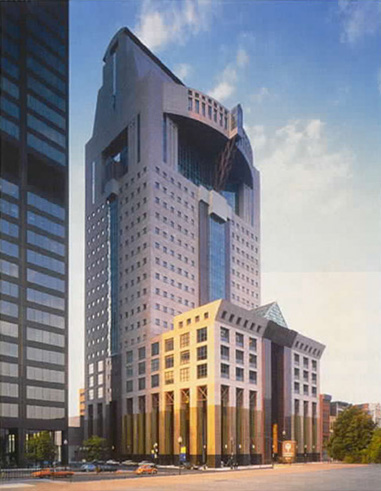Art Deco
The Art Deco style was an echo of the Machine Age and became popular in the 1920s. It was stylized by geometric decorative elements and a vertically oriented design. Towers and other projections above the roofline enhance the vertical emphasis of this style while flat roofs, metal window casements, and smooth stucco walls with rectangular cut-outs are symbolic of the Art Deco exterior. Facades are marked with zigzags and other stylized floral, geometric and sunrise motifs. A distinctly urban style, Art Deco in American architecture was used widely and popularly for commercial buildings during this period.
Colonial
More than simply the design elements, Colonial architecture refers to the time period in American architecture, between the early 1600s, when the first colonists began to build settlements and 1776, the year the colonies declared their independence from England. Economical, refined and basic, the colonial designs reflect the buildings practices of America's early settlers. Although Colonial architecture is often thought of as stately and symmetrical with an orderly arrangement of windows, it actually comes in several sizes, shapes and styles reflecting the diverse cultural traditions of the English, Dutch, Spanish and French.
Contemporary
Contemporary-style homes became hugely popular between 1950 and 1970. There were two types of contemporary American architecture - the flat-roof type and the gabled roof type. These were characterized by odd-sized and often tall windows, lack of ornamentation, and unique mixtures of wall materials like stone, brick, and wood. Both types of designs were one-story tall and designed to incorporate the surrounding architectural landscape into their overall look.
Georgian
Fanciful and royal, the Georgian architecture was styled in honor of the first three monarchs of England, all of whom were named George. Formal and majestic Georgian homes are known for their refined and symmetrical design with paired chimneys and a decorative crown over the front door. Another unique feature is the orderly row of five windows across the second story. With sport side-gabled roofs, Georgian houses are two to three stories high, and constructed in brick. Besides symmetry, this kind of architecture is symbolized by rich classical detail such as large Greek or Roman style columns, elaborate entryways with beautifully arched windows resting atop them and elegant ornamentation.
Gothic Revival
Gothic Revival became popular in the mid 1800s. This style was largely influenced by English romanticism and intricate wooden millwork. It was characterized by Gothic windows with distinctive pointed arches and featured exposed framing timbers and steep vaulted roofs with cross-gables. They also included extravagant features such as towers and verandas.
International
European architects initiated the modern style of architecture in the 20th century. Using materials such as concrete, glass and steel, it was devoid of ornamentation or decoration. The architectural landscape in the international style introduced the idea of exposed functional building elements such as elevator shafts, ground-to-ceiling plate glass windows, and smooth facades.
Prarie House
The first Prairie-style house was designed by Frank Lloyd Wright in Chicago in 1893. This American architectural style peaked between the years 1900s and 1920s and focused on modest homes that blended the natural beauty of the Midwestern landscape. It consists of two main styles - boxy and symmetrical or low-slung and asymmetrical and the materials used are brick and clapboard. It has low pitched gable roofs with eaves extending well beyond the walls, creating an effect that allows it to blend with the scenery. Other details included pronounced overhangs, stone belts to accentuate the horizontal designs, rows of casement windows, one-story porches with massive square supports as well as stylized floral and circular geometric terra-cotta or masonry decorations around doors, windows, and cornices.
Shingle Victorian
This American architectural style was used widely in cottages along the trendy, wealthy North-eastern coastal towns of Long Island and Newport in the late 19th century. Wide porches, unadorned doors, windows, and cornices, steeply pitched roof lines are symbolic of this style. Continuous wood shingles cover the entire surface of the home, giving it a cohesive look. Some unique features in this style include dormers, recessed balconies, and side towers with bell or conical roofs structured under the shingles.
Tudor
This architecture was initiated in the 1920s and 1930s, but continues to remain a popular architectural style in suburbs across the United States even today. It is characterised by half-timbering on bay windows and upper floors with facades that are pronounced by one or more steeply pitched cross gables. Patterned brick or stone walls, rounded doorways, multi-paned casement windows, and large stone chimneys are also some of the features of this architectural style.
Victorian
Victorian architecture in America originated in the second half of the 19th century, when America was identifying new approaches to building and design. Victorian styles include Second Empire, Italianate, Stick, and Queen Anne among others. Advances in modern technology ensured the incorporation of ornamentation such as brackets, spindles, and patterned shingles into the Victorian designs.














